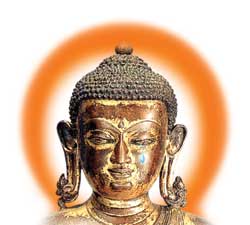 The number of people who call themselves Buddhists in Nepal has, according to the latest census, more than doubled in the last ten years. For an official Hindu kingdom, even one that boasts an entire administrative zone named after the Enlightened One, the sudden jump to ten percent is somewhat perplexing. After all, Buddhists haven't run an aggressive conversion campaign, nor has there been a huge influx of Buddhist refugees into the country. The reason behind the rise must then be simple: emboldened by democracy, many no longer feel the need to hide their non-Hindu identity.
The number of people who call themselves Buddhists in Nepal has, according to the latest census, more than doubled in the last ten years. For an official Hindu kingdom, even one that boasts an entire administrative zone named after the Enlightened One, the sudden jump to ten percent is somewhat perplexing. After all, Buddhists haven't run an aggressive conversion campaign, nor has there been a huge influx of Buddhist refugees into the country. The reason behind the rise must then be simple: emboldened by democracy, many no longer feel the need to hide their non-Hindu identity. Buddhism and Hinduism have evolved syncretically here. Having appropriated Lord Buddha as just another avatar of Vishnu, the Hindu orthodoxy here looks approvingly upon Vajrayana Buddhism. Janakpur, the birthplace of Sita, doesn't ring a bell in the assemblies of the global elite. But the moment Nepalis mention that Lord Buddha was in fact born in what is now Nepal (and not what is now India) they often succeed in getting the attention of everyone present anywhere in the world. The Buddha is a badge of honour for many symbol-starved Nepalis.
Convenience is another factor that makes Nepalis accept Buddhism with relative ease. Nepalis abroad sometimes pretend to be Buddhist in order to prove their \'non-Indian' identity. Nepali medical students in Pakistan have been known to pass themselves off as Buddhist, just so they don't get hassled.
The fascination of the Nepali power elite with the Buddha and his birthplace is on display in the excesses of the Lumbini Development Trust, where a new set of bosses takes over after every change of government at Singha Darbar. Ever since former UN Secretary General U Thant wept on a visit to Lumbini in 1967, and King Mahendra recognised the importance of those precious drops of tears, the place has been sold to the world as a pilgrimage site.
After a long-drawn controversy, the temple of Mayadevi is finally being built at Lumbini. However, the frantic pace of construction hides the fact that the implementation of the infamous "Master Plan" has been dragging on for years. We overestimated the desire of international Buddhists to donate generously to make Lumbini a world landmark. And despite the stewardship of highly-placed individuals-the present king himself used to chair the Lumbini Development Trust-the organisation has failed to attract the generosity of the world Buddhist community.
Besides the usual accusations of cronyism and nepotism that continue to undermine the efficiency of the Trust, the rapid turnover of its key personnel in the last twelve years has also been a factor in its stagnation. But quite apart from all these factors, keeping the Dalai Lama away from Lumbini is probably what has really prevented the project from taking off.
It seems absurd, but the Lumbini Development Trust has made no effort to date to get the Dalai Lama to visit the birthplace of Lord Buddha. Fear of rubbing the Chinese the wrong way may have prompted our government to exercise restraint-the Dalai Lama is, after all, not just the spiritual, but also the temporal, head of Tibetans in exile. But there is really no need for the Lumbini Development Trust to follow suit.Lumbini won't grab the attention of the world as long as it insists on keeping the most illustrious of Buddhists off its soil. Sure, the Chinese are touchy about him, but the Dalai Lama is considered a reincarnation of the Buddha by most followers (some of them high-flying Hollywood stars, we might add) and he has won the Nobel Peace Prize.
In his Lumbini Chakra hypothesis, architect Shankar Nath Rimal argues that the Lumbini Garden contains symbolic representations of almost all the important events of the Buddha's life. Rimal further posits that a part of the Buddha's mortal remains might also have been buried at Lumbini. If that can be proven, the place will take on even more significance for devout Buddhists.
The responsibility for inviting the Dalai Lama to Lumbini lies primarily with the management of the Trust. But that doesn't mean that His Holiness shouldn't make his own efforts. There are other countries in the world where Buddhists have welcomed the Dalai Lama even if their governments were less than keen. Maybe Nepal's 2.3 million Buddhists also have a say in this? Chinese dignitaries on official visits to Nepal now have Lumbini on their itinerary, so the Chinese government may someday see that it is in its own long-term interest to allow the Buddha's most eminent contemporary disciple to visit the place of his birth too?



